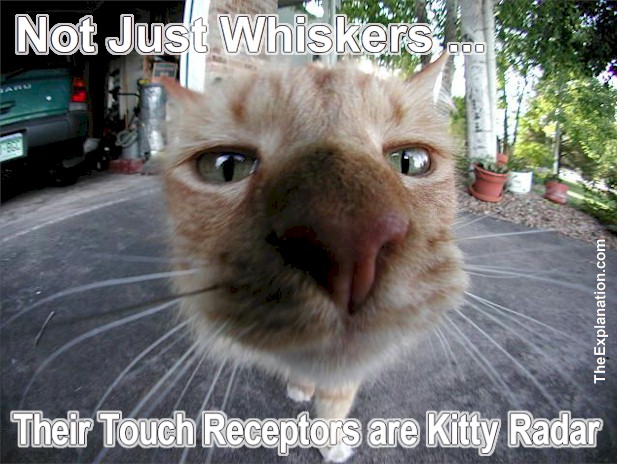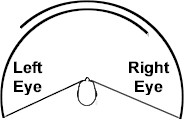Contents
Animal senses are superior to man in every instance. Sight, hearing, smell, taste and touch animals beat mankind hands down.

Animal senses are superior to man in every instance. Sight, hearing, smell, taste and touch animals beat humankind hands down. Cat whiskers are kitty radar.
With their animal senses they can see, hear, smell, taste, and feel much better than humans can. We have several examples of animal abilities before us in this article and below.
(Inventory of the Univers, chapter 10.3)
Sight:

A Human’s peripheral vision is rather limited compared to that of a donkey and many other animals.
A grown woman’s field of peripheral visions encompasses 200 degrees. With both eyes, she basically has very little peripheral vision: a sliver of twenty degrees.
In contrast, donkeys survey their world in a 285-degree scope. This is almost a full circle.
They can see all four of their legs when they are walking. Rabbits and horses, whose eyes are positioned on the sides of their heads, can see the entire sphere. Their world is seen in 360 degrees. They use this total peripheral vision to guard against danger and predators.
Hearing:
Human hearing is limited to a minimum frequency of twenty hertz and a maximum frequency of twenty kilohertz. Dogs can hear higher frequencies than you and I can: up to sixty sixty kilohertz. This is shrill enough to detect a dog whistle.
Cats can hear their prey’s ultrasonic calls up to a frequency of about eighty kilohertz, and their pivotable ears hone in on a sound’s direction. Bats and dolphins can hear up to 160 kilohertz. On the lower end of the scale, elephants and moles can hear “infrasounds,” or pitches below the range of human hearing. This allows them to detect the vibrations of earthquakes.
Smell:
Pigs have twenty-eight olfactory nerves in their noses, while a goat has twenty one. This is in contrast to our human two. Dogs have noses millions of times more sensitive than us, which allows them to follow day-old trails, find missing persons, and sniff out drugs and explosives. Their keen smell can even detect termites and bed bugs.
Taste:
Compared to humans with our 10,000 taste buds, the catfish’s body is covered with tens of thousands of taste buds. Catfish live and feed in murky, muddy waters. Although they have eyes, their taste buds allow them to locate a morsel in an Olympic-size swimming pool. Butterflies have taste sensors on their feet, which permit them to know both what is good for food and where to lay their eggs.
Touch:
Cats can use their whiskers to “touch” a space and sense whether it is too small. Similarly, a seal’s whiskers have many more nerve fibers and can feel fish 180 meters away. This distance is equal to about four lengths of an Olympic swimming pool.
Cats can sense earthquakes because the fine touch receptors in their paws detect tremors in the ground. Similarly, catfish, which have smooth skin, can feel earthquakes using their finely developed sense of touch as can the star-nosed mole which has six times more touch receptors in its nose than humans have in their hands.
A manatee senses fish many miles away thanks to the many tactile hairs that cover its body. We talk about things that make the hair on our arms stand up, but the manatee’s hairs are far more sensitive.
Eyesight
|
Animals
|
Humans
|
| Buzzards can see small rodents from a height of 15,000 ft. They have one million photoreceptors per square millimeter. Jumping spiders have regular and ultraviolet vision.
They see both night and day. Camouflaged prey glow a bright blue-green and don’t stand a chance. |
Man takes a beating in each of these areas separately, but in a pentathlon including all these senses, man would fare better in comparison to the animals with their animal senses. |
Hearing
|
Animals
|
Humans
|
| Dogs can hear a can of their food being opened and make good watch dogs because they can hear a pin drop.
This pales into insignificance compared to the ultrasound hearing of the Eurasian Greater Wax Moth at 300 kilohertz. |
Remember, human hearing is limited to a maximum frequency of twenty kilohertz. |
Smell
|
Animals
|
Humans
|
| Sharks can detect one drop of blood in 10,000 liters of water. Bears can smell food twenty-nine kilometers (eighteen miles) away.
The grizzly bear can smell a carcass some twenty-five kilometers away, and they know what eau de cologne you’re wearing long before you ever see them. |
With six million olfactory receptors, man is feeble compared to a dog’s 220 million. Nonetheless, man can distinguish thousands of various odors.
Using his smell and taste together, mankind can differentiate the infinite variety of aromas of wines from around the world. |
Taste
|
Animals
|
Humans
|
| Flies know what to expect when landing on food because they have taste buds in both their feet and proboscis.
Cows and herbivores in general, with their animal senses including taste, have more taste buds than humans. As they munch away, they can easily detect dangerous plants and move on to safer grazing. |
Our taste buds are concentrated on the tongue and its immediate mouth area.
This allows us to detect five basic tastes: salty, sour, bitter, sweet and umami, which is associated with glutamates. |
Touch
|
Animals
|
Humans
|
| Crickets have hairs under their abdomen that are so sensitive that the slightest change of movement in the air warns them that an unwelcome guest is approaching. | Certain people can “sense” someone in their presence. Otherwise, our maximum reach is our arm’s breadth. |
Individual animal senses are generally characteristic to a specific animal. It is that advantage that is their major asset for hunting and protection.
This post is an excerpt from chapter 10.3 of Inventory of the Universe.
The Explanation Blog Bonus
This video is about noses. Not all noses are equal, and not all animals have noses.
We don’t hear much about wolverines … here’s a short video about their sense of smell.
Dig Deeper into The Explanation
Online Study Courses to Uncover the Mystery of Adam and Eve’s Nakedness… with no fuss. Free video mini-course revealing the God-intended meaning of Scripture via Biblical Hebrew. It’s so easy, it’ll blow you away. Join now and add new motivation to your Bible study.
Join The Explanation Newsletter to stay informed of updates. and future events. No obligations, total privacy, unsubscribe anytime, if you want.
The Explanation series of seven books. Free to read online or purchase these valuable commentaries on Genesis 1-3 from your favorite book outlet. E-book and paperback formats are available. Use this link to see the details of each book and buy from your favorite store.

Since you read all the way to here… you liked it. Please use the Social Network links just below to share this information from The Explanation, Animal Senses – Light-years Beyond what Mankind is Capable of … Why?



Trackbacks/Pingbacks